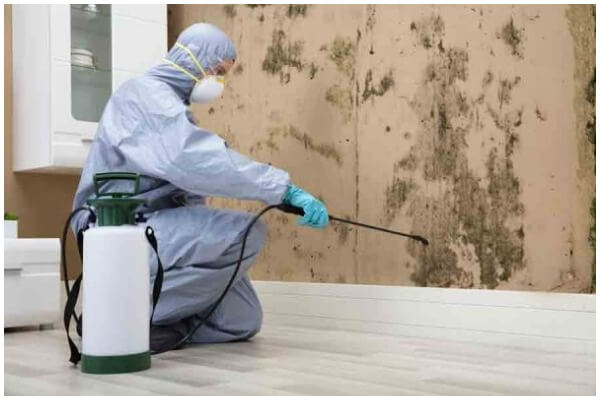Nobody certainly likes mold growth in their homes, especially not in the kitchen. Mold is unsightly and poses a serious threat to your family’s health. Unfortunately, bathrooms and kitchens are prone to mold growth due to the high moisture and humidity levels.
Mold growth in the kitchen is common under the sink, cupboards or cabinets, appliances, walls behind sinks and taps, and kitchen furniture. To prevent mold from forming in your kitchen, or to remove mold growth, you should first identify factors that favor mold growth in the kitchen.

Common Causes of Mold Growth in the Kitchen
Understanding the causes of mold growth in the kitchen is key to preventing mold infestation. Mold grows in the kitchen because of the following:
- Dampness, high humidity, and water leaks
Water leaks are the number one cause of mold growth in the kitchen and bathroom. Leaks provide the much-needed growth factor for mold, which is moisture. Leaks from the kitchen sink provide the perfect conditions for mold growth. This explains why mold is commonly found under kitchen sinks.
Apart from leaks, damp kitchen surfaces and high humidity levels also trigger mold growth. Kitchens are generally hot and humid, making them a favorite place for mold growth.
Also Read: 7 Awesome Mini Kitchenette for Small Kitchen (Update 2022)
- Darkness and adequate food supply
Mold and mildew also grow well in dark environments and areas with enough nutrient supply. If mold spores find such conditions, they can grow and spread within a day. Unfortunately, there’s plenty of food and a dark environment in the kitchen, which contribute to mold growth. Rotten food, even if kept in the refrigerator, encourages mold growth.
- Trash cans and garbage disposals
Trash cans and garbage also provide the perfect environment for mold growth. The trash can is moist, dark, and has sufficient food leftovers for mold colonies to spread. Garbage disposals have the same conditions.
- Kitchen tools and appliances
Kitchen tools, especially those used regularly to prepare food, are excellent surfaces for mold growth. Therefore, you should pay close attention to these appliances after use. Wooden cutting boards, spoons, and other wooden surfaces provide enough substrate to encourage mold growth.
How to Prevent Mold Growth in the Kitchen
While the kitchen presents many surfaces for mold growth, creating a mold-free kitchen shouldn’t be challenging. Below are a few tips for preventing mold growth in the kitchen:
1. Clean the kitchen regularly
Kitchen contaminations range from dust and dirt to rotten food and other organic materials. Unfortunately, mold grows in visible places and areas out of sight. Even with the utmost caution, you can’t prevent food from getting on the floor. However, you can prevent mold growth by cleaning kitchen surfaces thoroughly.
Kitchen cleaning should include hard-to-reach areas, such as the drain and under the sink. While areas under the sink and drain are rarely visible, they should be cleaned at least once every month. If you notice food or water spots in the kitchen, wipe them immediately lest you forget. As mentioned, it takes only a day for mold colonies to form.
2. Discard spoiled food
You should check food materials at the bottom of the cabinet or fridge drawers regularly. Most people presume mold can’t form in such cold conditions. However, mold grows even in low temperatures. Therefore, besides ensuring no leftovers, proper disposal of food remnants is important.
Spoiled fruits and vegetables are excellent breeding grounds for mold. You should place any rotting food in the garbage disposal immediately.
3. Monitor kitchen humidity levels
Mold grows well in high humidity. Therefore, you should regulate humidity levels to prevent mold growth. Fortunately, regulating humidity in your kitchen isn’t difficult. For instance, leaving your windows open during the day excellently maintains humidity levels. If you are concerned about heat loss during winter, opening all windows for five to ten minutes is enough to regulate indoor humidity.
Humidity levels are usually high during summer because of high temperatures, especially in areas with a high humid climate. Apart from opening your windows, you can also use dehumidifiers to regulate humidity. Test your base humidity levels and adjust dehumidifiers to maintain these levels. However, remember that low humidity can affect your health. While mold can’t grow in such conditions, low humidity leads to dry skin, an itchy nose, and a scratchy throat.
4. Check for leaks regularly
Mold certainly loves moisture. While humidity is the main contributor, flooding and water leaks also promote mold growth and water damage. Therefore, you should inspect kitchen plumbing regularly to ensure they don’t leak. While at it, don’t forget to check the dishwashing machine. Call for professional plumbing immediately if you find leaks.
Conclusion
Washing dishes daily, cleaning appliances immediately after use, and cleaning cabinets and storage spaces also prevent mold growth in the kitchen. Ensuring your kitchen is free from mold provides a clean and pleasant space for food preparation. However, in the unlikely event mold grows in your kitchen, you should take immediate steps to remove mold.